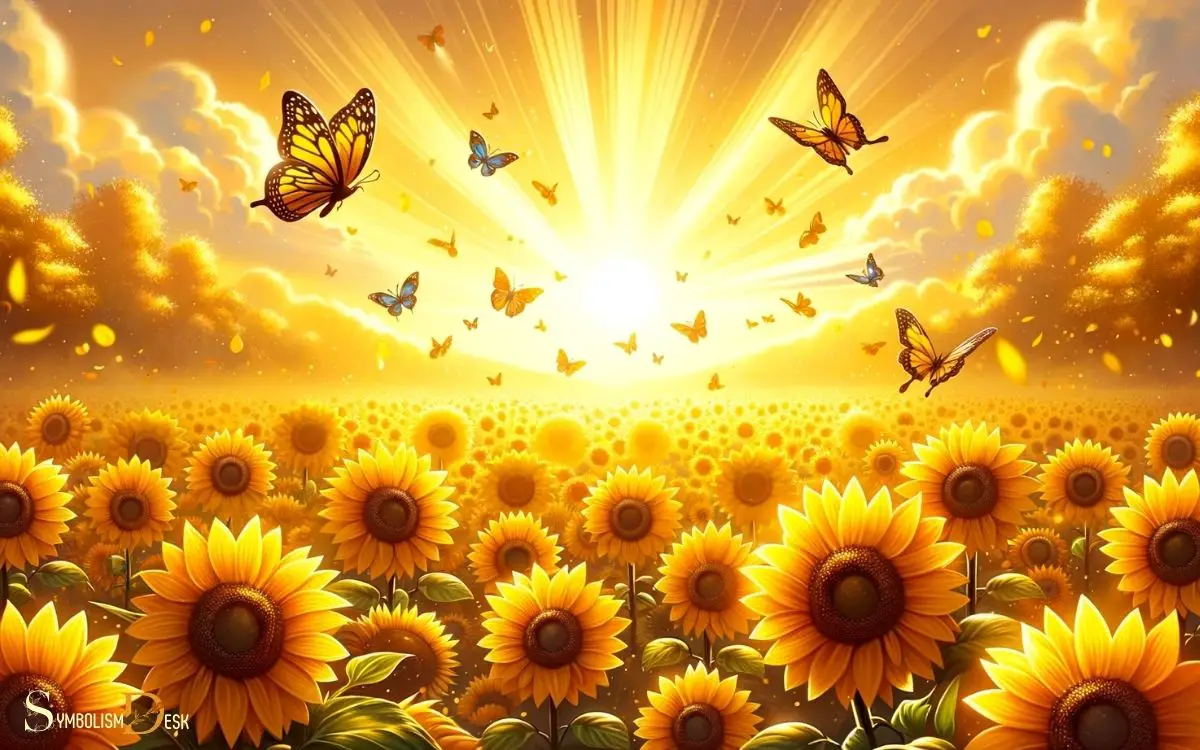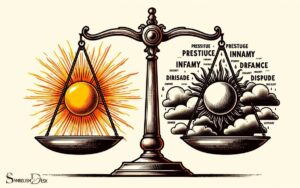What Is the Symbolic Meaning of the Color Yellow? Optimism!
The color yellow often symbolizes happiness, optimism, enlightenment, and creativity, embodying the cheerfulness of a sunny day. It can also represent caution or decay in specific contexts, demonstrating its diverse symbolic range.
Yellow is a color that carries significant symbolic meaning across various fields:
- Happiness and Positivity: Yellow is associated with the warmth of the sun, often evoking feelings of joy and cheerfulness.
- Caution and Alertness: In traffic lights and road signs, yellow demands attention and signals caution, urging us to remain alert.
- Enlightenment and Intellect: In many cultures, yellow is connected with knowledge and learning, symbolizing intellectual energy and enlightenment.
- Creativity: As a bright and stimulating color, yellow can inspire original thought and creativity.
- Decay and Disease: In some instances, yellow indicates sickness or decay, such as the yellowing of leaves or the historical association with quarantine.
Example: In the Buddhist tradition, yellow robes are worn by monks to signify humility and separation from materialistic society.
Yellow’s dual nature reminds us of life’s contrasts, from the joy of sunlight to the caution of a yellowed warning sign.

Key Takeaway
Historical Significance of Yellow
Yellow has held historical significance as a symbol of wealth and power in various cultures throughout history. In ancient Egypt, yellow was associated with gold, the sun, and the pharaohs, representing their divinity and eternal power.
In China, during the Ming and Qing dynasties, only the emperor was allowed to wear yellow, as it symbolized his imperial power.
In medieval Europe, yellow was linked to Judas Iscariot and betrayal, yet it was also used in depictions of the Virgin Mary to convey her compassionate and nurturing nature.
These historical connections have contributed to the enduring associations of yellow with prestige, authority, and positivity in many societies.
Understanding the historical connotations of yellow provides insight into its symbolic meaning and the cultural significance it has held over time.
Cultural Associations With Yellow
Throughout various cultures, yellow is associated with different symbolic meanings and cultural significance. In some cultures, yellow represents happiness, joy, and wisdom, while in others, it may symbolize courage, peace, and prosperity.
Here are some cultural associations with the color yellow:
| Culture | Association |
|---|---|
| China | Imperial power, prosperity |
| Egypt | Mourning, happiness |
| India | Merchants, farmers |
| Japan | Courage, love, and emotion |
| Native American | Enlightenment, positivity |
These associations demonstrate the diverse ways in which yellow is perceived and valued across different cultures, adding depth and complexity to its symbolic meaning.
Understanding these cultural associations can offer insight into the rich tapestry of human experience and the varied interpretations of color symbolism.
Psychological Effects of Yellow
The color yellow has a range of psychological effects that are worth exploring. It’s often associated with happiness, evoking feelings of joy and positivity.
Additionally, yellow is known to stimulate creativity and inspire an optimistic outlook on life.
Yellow and Happiness
Psychologists have found that exposure to the color yellow can evoke feelings of happiness and warmth in individuals. This is due to the psychological effects of yellow, which have been observed in various studies.
The color yellow can have a profound impact on one’s emotional state, leading to increased feelings of joy and positivity.
Here are four ways in which yellow can affect one’s emotional well-being:
- Mood Enhancement: Yellow is known to uplift mood and create a sense of cheerfulness.
- Stimulates Creativity: It can stimulate creative thinking and enhance mental agility.
- Promotes Optimism: Yellow encourages an optimistic outlook on life and a positive attitude.
- Energizing: The color yellow can provide a burst of energy and increase feelings of vitality.
Understanding these emotional responses to the color yellow can provide insights into its symbolic meanings and cultural significance. It’s also closely related to the subsequent section about ‘yellow and optimism’. Yellow is often associated with feelings of happiness, warmth, and positivity, making it a popular choice for clothing, home decor, and marketing materials. In many cultures, yellow is also associated with qualities such as intellect, energy, and enlightenment. Understanding these emotional responses to the color yellow can provide insights into its symbolic meanings and cultural significance. It’s also closely related to the subsequent section about ‘yellow and optimism’. Additionally, exploring the red symbol meaning explanation can further enhance our understanding of the significance of yellow and its impact on human emotions and perceptions.
Yellow and Optimism
Yellow’s psychological effects on individuals extend to fostering optimism and a positive outlook on life. The color yellow is often associated with feelings of happiness and warmth, which can have a direct impact on one’s psychological state.
When people are surrounded by yellow, it can evoke a sense of hope and positivity. Studies have shown that exposure to yellow can increase serotonin levels in the brain, which is responsible for regulating mood and promoting feelings of well-being.
This boost in serotonin can lead to an overall uplift in mood and a more optimistic mindset. Therefore, incorporating yellow into one’s environment or daily life can help maintain a positive and hopeful attitude.
This positive psychological effect of yellow can also influence an individual’s creativity and innovation.
Yellow and Creativity
Associated with fostering optimism and a positive outlook on life, yellow also plays a significant role in influencing creativity and innovation in individuals.
The psychological effects of the color yellow on creativity are profound and can be observed in various ways:
- Stimulates mental activity: Yellow is known to stimulate the mental processes, encouraging creativity and enhancing problem-solving abilities.
- Boosts energy levels: The color yellow has been linked to increased energy levels and a greater willingness to explore new ideas and concepts.
- Promotes positivity: By evoking feelings of happiness and positivity, yellow can create an environment conducive to creative thinking and innovation.
- Encourages communication: Yellow is also associated with improved communication and can inspire individuals to express their ideas more freely.
Understanding the psychological impact of yellow on creativity can help individuals harness its potential in various aspects of their lives.
Yellow in Art and Literature
In art and literature, the color yellow is often used to convey warmth, joy, and optimism. Artists and writers frequently employ yellow to evoke a sense of happiness and positivity.
For instance, Vincent van Gogh’s famous sunflower paintings are a striking example of how yellow is used to create an atmosphere of vibrancy and cheerfulness.
In literature, the color yellow is often associated with enlightenment and intellect. In F. Scott Fitzgerald’s ‘The Great Gatsby,’ the symbol of the yellow car represents wealth and extravagance.
Additionally, yellow can symbolize caution or cowardice in various works of literature, adding depth and complexity to the portrayal of characters and themes.
Yellow in Religion and Spirituality
Yellow holds significant meaning in various religious and spiritual contexts. It’s often associated with specific religious symbolism and holds spiritual significance in different belief systems.
Exploring the role of yellow in religious and spiritual practices can provide valuable insights into the symbolic power of this vibrant color.
Yellow in Religious Symbolism
Throughout history, various religious traditions have revered the color yellow for its symbolic associations with enlightenment, divinity, and spiritual awakening.
In religious symbolism, yellow often represents the following:
- Divine Light: Yellow is often associated with the divine light that illuminates the path to spiritual enlightenment and understanding.
- Purity and Holiness: In many religions, yellow symbolizes purity, holiness, and the divine presence, evoking feelings of reverence and awe.
- Renewal and Rebirth: The color yellow is often linked to themes of renewal and rebirth, signifying the eternal cycle of life and the promise of new beginnings.
- Inner Wisdom: Yellow is thought to stimulate mental clarity and wisdom, serving as a reminder to seek inner truth and spiritual growth.
These symbolic associations with yellow in religious and spiritual contexts inspire feelings of reverence, hope, and inner awakening.
Spiritual Significance of Yellow
The symbolic significance of the color yellow in religious and spiritual contexts can be further understood through its representation of enlightenment, purity, and renewal.
In many Eastern religions, yellow is associated with knowledge and learning, symbolizing the quest for spiritual growth and understanding.
In Hinduism, yellow is linked to the solar plexus chakra, signifying inner strength and self-awareness. In Buddhism, yellow is the color of freedom from worldly cares and the embodiment of the ultimate state of peace and happiness.
Additionally, in Christianity, yellow represents the divine presence and is often used in depictions of saints and angels.
Across various spiritual traditions, yellow holds a profound significance, serving as a visual reminder of the journey towards spiritual awakening and the pursuit of higher consciousness.
Symbolism of Yellow in Different Cultures
In different cultures, yellow holds diverse symbolic meanings.
- In many Western cultures, yellow represents happiness, positivity, and energy.
- In some Eastern cultures, yellow is associated with courage, positivity, and prosperity.
- In ancient Egypt, yellow was connected to the sun god Ra and symbolized eternity and divinity.
- In Hinduism, yellow is the color of knowledge and learning, often worn by scholars and teachers.
These cultural variations showcase the rich and multifaceted symbolism of the color yellow around the world. Understanding the cultural significance of yellow can help foster appreciation and respect for diverse traditions and beliefs.
How does the symbolic meaning of the color yellow compare to the symbolic meaning of the evil eye color?
In the symbolic chart evil eye color, yellow represents positivity, warmth, and happiness. On the other hand, the evil eye color signifies protection from negative energy and harmful intentions. While yellow symbolizes joy, the evil eye color is believed to ward off malevolent glances. Both colors carry significant symbolic meanings in different cultural contexts.
Expressing Emotions Through Yellow
Yellow often brings out feelings of joy and warmth in those who experience it. This vibrant color is commonly associated with happiness, positivity, and energy.
When people express emotions through yellow, it often represents optimism, hope, and cheerfulness. It has the power to evoke feelings of happiness and contentment.
In art therapy, yellow is used to symbolize feelings of joy and to uplift individuals who may be feeling down. Moreover, yellow is often used in interior design to create a welcoming and uplifting atmosphere, as it can help to brighten and energize a space.
Whether it’s through clothing, décor, or art, the use of yellow allows people to convey and experience emotions associated with brightness and positivity.
Conclusion
The color yellow symbolizes warmth, happiness, and positivity across various cultures and time periods. From ancient civilizations to modern art and literature, yellow has been associated with joy, enlightenment, and creativity. Its psychological effects can uplift spirits and inspire optimism.
Whether it’s the golden glow of the sun or the vibrant hue of a field of flowers, yellow evokes feelings of brightness and cheerfulness in the hearts of those who behold it.






